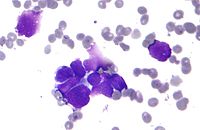
A review of bioselenol-specific fluorescent probes: Synthesis, properties, and imaging applications.
Sign Up to like & getrecommendations! Published in 2020 at "Analytica chimica acta"
DOI: 10.1016/j.aca.2020.03.027
Abstract: Bioselenols are important substances for the maintenance of physiological balance and offer anticancer properties; however, their causal mechanisms and effectiveness have not been assessed. One way to explore their physiological functions is the in vivo detection… read more here.
Keywords: review bioselenol; specific fluorescent; fluorescent probes; bioselenol specific ... See more keywords

Imaging and Detection of Hepatocellular Carcinoma with a Hepatocyte-Specific Fluorescent Probe.
Sign Up to like & getrecommendations! Published in 2022 at "Analytical chemistry"
DOI: 10.1021/acs.analchem.1c05540
Abstract: Hepatocellular carcinoma is a highly invasive malignant tumor of the liver, which is the main cause of cancer-related death. The cancerization of hepatocytes may lead to the changes of cell microenvironment, active substances, and enzymes.… read more here.
Keywords: hepatocellular carcinoma; detection; carcinoma; specific fluorescent ... See more keywords

A Mitochondria-Specific Fluorescent Probe for Visualizing Endogenous Hydrogen Cyanide Fluctuations in Neurons.
Sign Up to like & getrecommendations! Published in 2018 at "Journal of the American Chemical Society"
DOI: 10.1021/jacs.7b12545
Abstract: An ability to visualize HCN in mitochondria in real time may permit additional insights into the critical toxicological and physiological roles this classic toxin plays in living organisms. Herein, we report a mitochondria-specific coumarin pyrrolidinium-derived… read more here.
Keywords: fluorescent probe; probe; hcn mitochondria; mitochondria specific ... See more keywords

A water-soluble and highly specific fluorescent probe for imaging thiophenols in living cells and zebrafish
Sign Up to like & getrecommendations! Published in 2019 at "New Journal of Chemistry"
DOI: 10.1039/c9nj00324j
Abstract: A water-soluble and highly specific fluorescent probe was developed to track thiophenols in living cells and zebrafish. read more here.
Keywords: fluorescent probe; soluble highly; specific fluorescent; highly specific ... See more keywords

Abstract 350: Study of A3 adenosine receptor interactions and identification of novel ant-/agonist using a specific fluorescent probe
Sign Up to like & getrecommendations! Published in 2023 at "Cancer Research"
DOI: 10.1158/1538-7445.am2023-350
Abstract: Introduction: Adenosine receptors belong to G protein-coupled receptors (GPCRs). There are four types of adenosine receptors (A1, A2A, A2B, and A3). These receptors play roles in several pathological conditions. It has been proven that the… read more here.
Keywords: a3ar; specific fluorescent; fluorescent probe; adenosine receptor ... See more keywords

Quantitative Structure-Activity Relationship of Fluorescent Probes and Their Intracellular Localizations
Sign Up to like & getrecommendations! Published in 2023 at "Chemosensors"
DOI: 10.3390/chemosensors11050310
Abstract: The development of organelle-specific fluorescent probes has been impeded by the absence of a comprehensive understanding of the relationship between the physicochemical properties of fluorescent probes and their selectivity towards specific organelles. Although a few… read more here.
Keywords: organelle specific; relationship; fluorescent; model ... See more keywords